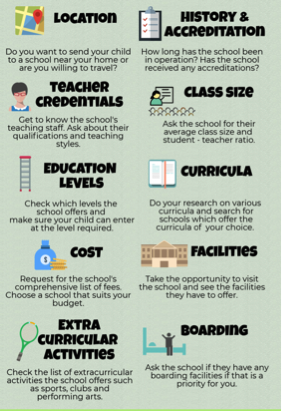“ How much better to get wisdom than gold, to get insight rather than silver!”
Proverbs 16:16 (NIV)
“Education breeds confidence. Confidence breeds hope. Hope breeds peace.”
Confucius
Discover the purpose of your work and your corporation
What is your purpose in work?
- Provide diverse education to local and international students, enabling academic achievement, personal growth, and lifelong learning.
- Cultivate a secure, joyful environment to nurture responsible citizenship.
What drives your corporation’s core value?
- Foster diverse global learning experiences and instill benevolence in youth.
- Create social impact globally while ensuring financial stability for investors.
The oldest international school in the world: Ecole Internationale de Genève founded in 1924

1.0 Executive Summary
Mission:
- Establish 10 new international schools in major cities within the first 10 years, each accommodating 1,000 students from K – Year 12.
Key Management Team:
- Mentors: Visionary pioneers and industry leaders with a global network, offering guidance and inspiration.
- Coaches: Mission-oriented industry experts providing practical solutions and keeping the team focused.
- Partners:
- Top international schools with operations in Southeast Asia or a disruptive vision.
- Funding specialists in international school education.
- Developers with land resources.
- Community support groups.
Product Benefits:
- High-quality teaching, counselling, and extracurricular programs.
- Exposure to diverse international cultures.
- Enhanced English language skills for host country students.
- Encouraging adaptability and mutual support among students.
- International curriculum for broader acceptance.
Target Market:
- Expatriates, APAC, and local residents in target cities: Kota Kinabalu, Sandakan, Tawau, Kuching, Miri, Samarinda, Balikpapan, Pontianak, and the new capital.
Financial Projections:
- Investment: $126 million for 10 international schools.
- Building Fees: $126 million in contributions.
- Operating Costs: $70 million per year for 10 schools.
- Revenue: $140 million per year from 10 schools.
- Income: $70 million per year.
- Payback: 4 years (from full intake).

Unique Business Model:
- Experienced team with a successful track record in international schools.
- Integration of top project leaders, school operators, funding, land resources, and a strong market strategy.
- Anticipated growth due to the new Indonesian capital and increased economic activities attracting foreign and local managers with families.
2.0 Mission
2.1 Problem
- Challenge: International schools in Asia grapple with growth and income challenges.
- Demand: The new Indonesian capital and increased investments will attract more expatriate families.
- Shortage: Numerous Borneo cities lack access to international schools.
- Standard: Local students seek English-medium education and an international curriculum for a competitive edge and global perspective.
2.2 Solution
- Alignment: Forge partnerships with existing international schools.
- Demand: Seize the opportunity to establish new international schools for expatriate and local students seeking an international curriculum.
2.3 Mission
- Schools: Establish 10 new international schools in major cities: Kota Kinabalu, Sandakan, Tawau, Kuching, Miri, Samarinda, Balikpapan, Pontianak, and the new capital (2).
- Target: Aim to accommodate 5% of the influx of foreign expatriates needing international education for their children.
- Goal: Each school will serve 1,000–1,200 students from Year 1 to Year 12.
- Time: Open 10 new international schools within the first decade.
3.0 Product
3.1 Product Description
- Scope: The international schools offer an international curriculum catering to both expatriate communities and local students.
- Format: The curriculum aligns with the specific educational standards of expatriates’ home countries, such as the UK, USA, France, Germany, Sweden, Australia, and others.
3.2 Product Attributes
International schools share common characteristics:
- Accreditation: Offer internationally recognized curricula like International Baccalaureate, Cambridge Assessment International Education, International Primary Curriculum, or national curricula from expatriates’ home countries.
- Mobility: The student population is highly mobile due to their families’ expatriate employment status.
- Diversity: Enrol students from international communities and the host nation, creating a culturally diverse multinational community.
- Language: Most instruction is conducted in English.
- Staff: Employ expatriate teachers, leaders, and senior management.
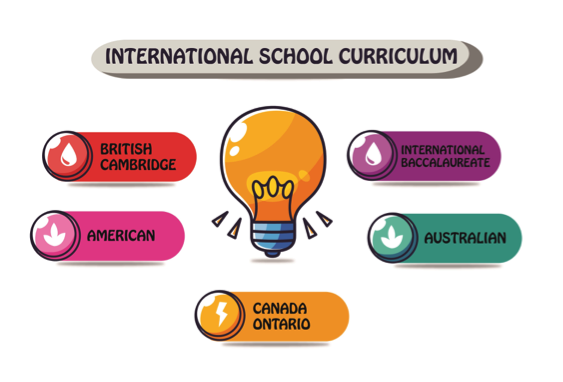
3.3 Product Benefits
- Quality: Deliver high-quality teaching, student counselling, and extracurricular programs.
- Diversity: Expose students to a richly diverse international cultural education.
- Language: Offer continuity in English-medium instruction for English-background students and improve English skills for host country students.
- Adaptability: Encourage students to adapt and collaborate due to high mobility.
- Acceptance: Provide an internationally recognized curriculum, opening doors to top global schools and universities for host country students.
- Rewards: Attract highly motivated foreign-trained teachers with benefits like overseas experiences, annual return airfares, accommodation subsidies, and exposure to diverse cultures.
3.4 Product Competitive Advantages
- Global Perspective: Foster a diverse and global outlook, promoting understanding and respect for different viewpoints and teamwork across nationalities.
- Interactivity: Develop cross-cultural learning methods and social interaction skills for future career growth.
- Language Learning: Offer opportunities for students to learn additional languages.
- Exposure: Provide extracurricular activities that immerse students in the host culture and local community.
4.0 Market
4.1 Market Segmentation
- Expatriate Segment: Students from expatriate families in host countries.
- APAC Segment: International students from Asia Pacific regions choose international schools abroad due to availability, affordability, flexible visas, proximity, and quality education.
- Local Segment: Local students with financial resources opt for international schools.
4.2 Target Market Strategy
- Partnerships: Collaborate with renowned international schools to enhance leadership.
- Boarding: Attract international junior students with boarding facilities.
- Industry Focus: Target sectors with high expatriate and local student demand.
- Differentiation: Stand out through reputation, teacher quality, curriculum, pricing, facilities, success rates, flexibility, extracurriculars, and location.
- Marketing: Use multimedia for effective branding.
- Key Attributes: Address specific parental preferences in international schools.
4.3 Market Needs
- Global: In 2017, there were over 8,000 international schools with 4.5 million students, and 50-80% of enrollments were from host countries. By 2027, the student population is projected to grow to 8.7 million.
- Local: In Borneo, the growth of international schools will be driven by new investments and industries.
- Growth: Indonesia’s capital relocation to Borneo is expected to create demand for 10-12K international students.
4.4 Growth Drivers
- Local: Middle-class parents seeking international education for their children to prepare them for Western universities.
- Expat: Increased foreign manager influx drives the need for international schools for expatriate communities.
- Regional: New international schools aim to attract international students from North Asia, drawn to Borneo as a popular tourist destination.
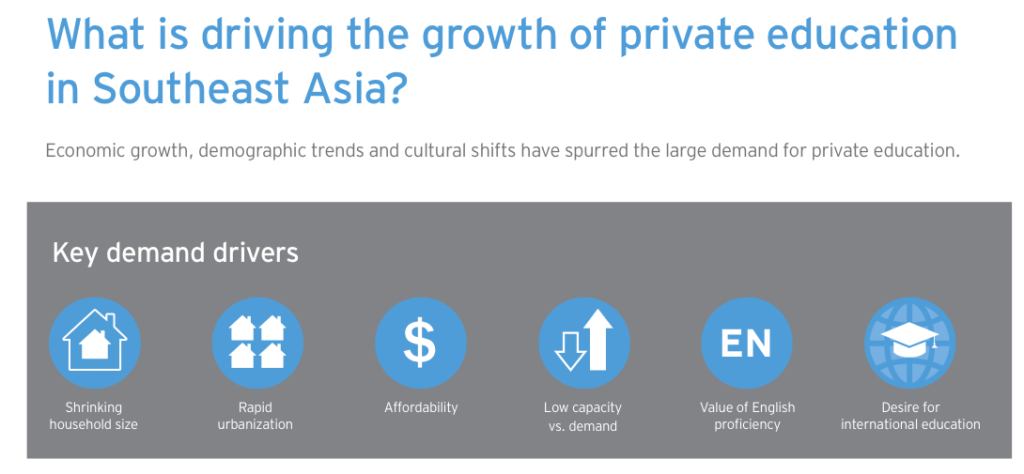
4.5 Key Customers
- Indonesia
- New Capital: Expected population of 6 million.
- Diplomats: Over 100 embassies in Jakarta.
- United Nations Agencies: More than 22 agencies.
- NGO Presence: 67 international registered NGOs in 2016.
- Journalists: The Jakarta Foreign Correspondents Club boasts over 400 journalists.
- Existing International Schools: 190 international schools in Jakarta in 2017.
- Expatriates: In 2018, there were 95,335 foreign expatriates, including professionals, managers, advisers, consultants, and board members.
- International Student Market
- Malaysia: In 2019, Malaysia hosted 127,583 international students from 100+ countries, with plans to reach 250,000 by 2025.
- China: Attracted 264,000 international students from Asia in 2016, with a goal of 500,000 by 2020.
- Taiwan: Attracted 116,000 international students in 2016.
- Japan: Approximately 40 accredited international schools in Japan, each with 100–1,500 students.
- Domestic Students from Host Countries
- Malaysia: In 2017, 39,161 local students in 170 international schools, with student numbers increasing by over 30% in Southeast Asia regions.
- Indonesia: In 2018, around 60,000 students attended 190 international schools.
- Brunei: International schools cater to about 1,800 international students from over 55 nations, with local students comprising 40-50% of enrolment.
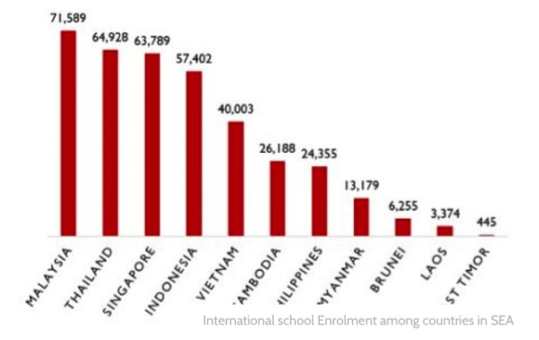

Source: IPSEF / Citizen Journals Lynn D’Cruz 2017
4.6 Competition and Industry
Key Players in International Private Schools in Southeast Asia
Singapore:
- Australian International School
- GEMS
- ISS International School
- Nexus International School
- One World International World School
- San Yu Adventist School
- Tanglin Trust School
- Singapore American School
- United World College of South East Asia
Malaysia:
- Alice Smith School
- British International School of Kuala Lumpur
- Epsom College Malaysia
- Garden International School
- International School of Kuala Lumpur
- International School of Penang (Uplands)
- Kolej Tuanku Ja’afar
- Marlborough College Malaysia
- Mont’Kiara International School
- Sri KDU International School
Thailand:
- Bangkok Prep
- International School Bangkok
- Shrewsbury International School Bangkok
- Bangkok Patana School
- Harrow International School Bangkok
- KIS International School
Indonesia:
- ACG School
- AIS (Australian Independent School)
- British School Jakarta
- Jakarta Intercultural School
- Mentari Intercultural School Jakarta
- Millennia World School
- New Zealand School
- Nord Anglia School
- North Jakarta Intercultural School
- SIS Pantai Indah Kapuk
International Schools in Borneo
Brunei:
- International School of Brunei
- Jerudong International School
Sabah:
- Charis International School
- Jesselton International School
- Kinabalu International School
Kalimantan:
- Pasir Ridge Intercultural School
- Raffles Independent School
Sarawak:
- Borneo International School
- Woodlands International School
- Lodge International School
- St Joseph’s International School
- Tunku Putra Help School
5.0 Operation
5.1 International School Key Goals
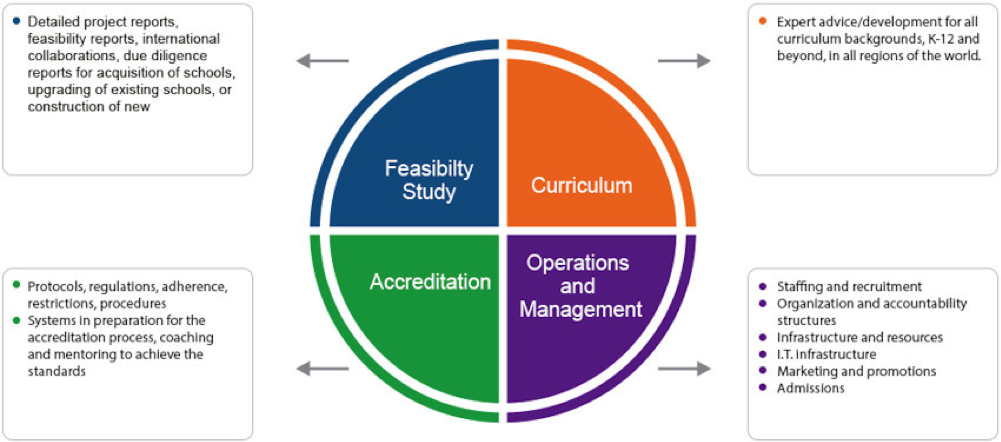
5.2 International School Development Process

5.3 International School Planning Stages
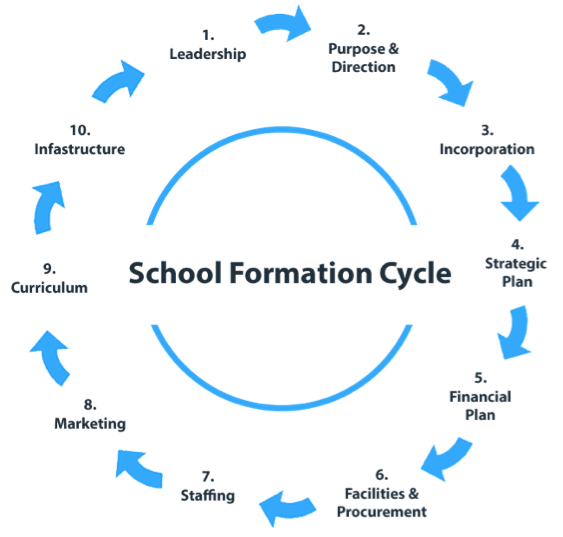
5.4 Teacher’s Professional Development
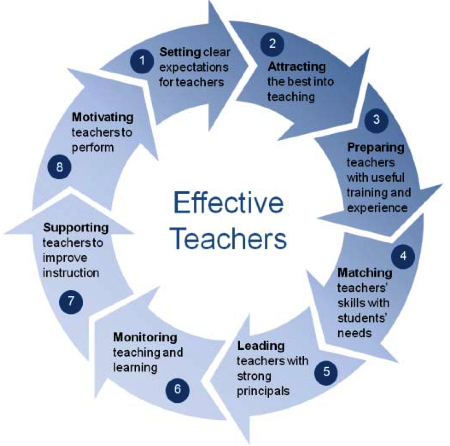
5.5 Curriculum Example
Some of the international school curriculum options:
- Advanced Placement (AP)
- American Curriculum
- Australian Curriculum
- British Curriculum (IGCSE)
- Cambridge Assessment International Education
- Edexcel
- International Baccalaureate (IB)
- International Primary Curriculum (IPC)
5.6 Scopes Of International School Management And Operations
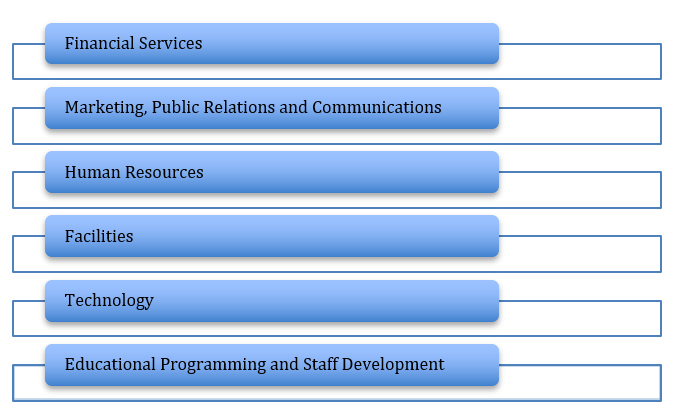
5.7 International School Life Cycle Time
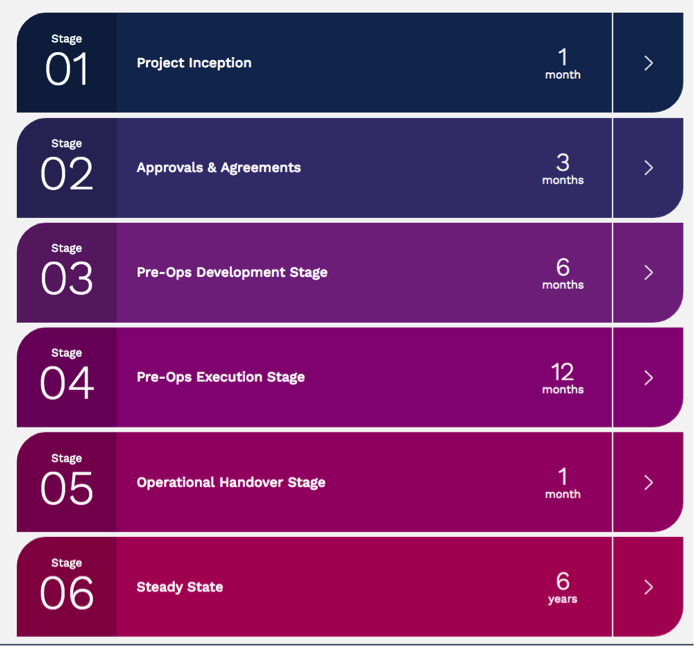
Source: EDUREACH 2021
6.0 Financial Implications
6.1 Investment Segment
International schools offer K–12 education for foreign and local students.
For one international school: • 1,000 students x 15 m²/student x US$700/m² = US$10.5 million • Add facilities and equipment (20%) = US$2.1 million • Total investment for one international school = US$12.6 million
For 10 international schools: • 10 international schools x US$12.6 million each = US$126 million
Case Studies
- Malaysia School (2021)
- Primary/Secondary: US$245–US$308/m²
- Primary school in 2015: US$3.5 million
- USA Schools (2014)
- Elementary school: 624 students, 7,868 m², US$16 million
- Middle school: 612 students, 11,000 m², US$26.5 million
- High school: 1,000 students, 16,000 m², US$45 million
- Australia Schools (2018)
- Public school: Standard primary school for 1,000 students, US$71.8 million
- Secondary school: School for 2,000 students, US$167.6 million
- Indonesia Construction Cost (2019)
- Building cost: US$400–700/m²
6.2 Production Cost
The production cost for running one international school is as follows: • Operation cost (includes 60 expat teachers) = US$5.4 million/year • Maintenance cost = US$1.6 million/year • Total cost for one international school = US$7.0 million/year
For 10 international schools, the total annual production cost would be: • 10 international schools x US$7 million each = US$70 million/year
6.3 Price and Revenue
- Building Fee Contribution
- Total cost for one school = US$12.6 million
- Year 1 building fee: 1,000 students x US$10,000 = US$10.0 million
- Outstanding building fee = US$2.6 million
- Yearly repayment = 90 new students x US$10,000 = US$900,000
- Repayment time = US$2.6 million / US$900,000 = 3 years
- (Note: Building fee contributions by the students can be paid as a one-time fee with a discount or spread over the number of school years.)
- Revenue: International School Fees
- For one school: 1,000 students x US$14,000/student = US$14 million/year
- For 10 schools: US$14 million x 10 schools = US$140 million/year
Case studies of other international school fees

6.4 Financial Returns
Revenue – Cost = Income School fee US$140 million – US$70 million = US$70 million/year
Case Studies
Case Study 1: International Schools in Asia Pacific and Middle East (2021)
Investment Range: $20 – $30 million
Student Capacity: 1800 pupils
School Type: K-12 International School
Profit Margin: 20-40%
Case Study 2: Private School in Bahrain
Projected Internal Rate of Return (IRR): 20-30%
Payback Period: 4-6 years
Case Study 3: Australian schools 2013-2017
School Average income Capex funding
Wesley College US$75.2 million US$69.9 million
Haileybury College US$70.9 million US$74.8 million
Caulfield Grammar US$68.8 million US$73.6 million
Knox Grammar US$60.6 million US$72.4 million
Melbourne Grammar US$50.3 million US$44.1 million
Pymble Ladies' College US$48.7 million US$48.9 million
Case Study 4: Field School Group Study Tours
Field School Study Tours during school holidays appeal to students seeking cultural experiences in other countries. These extracurricular activities can substantially enhance a school’s revenue.

Case Study 5: Profit Margins at Thailand International School
- 2019: Profit margins ranged from 7% to 31%
- 2018: Profit margins varied between 12% and 55%
- 2017: Profit margins were at 32%
2019 Financial Income of listed education groups
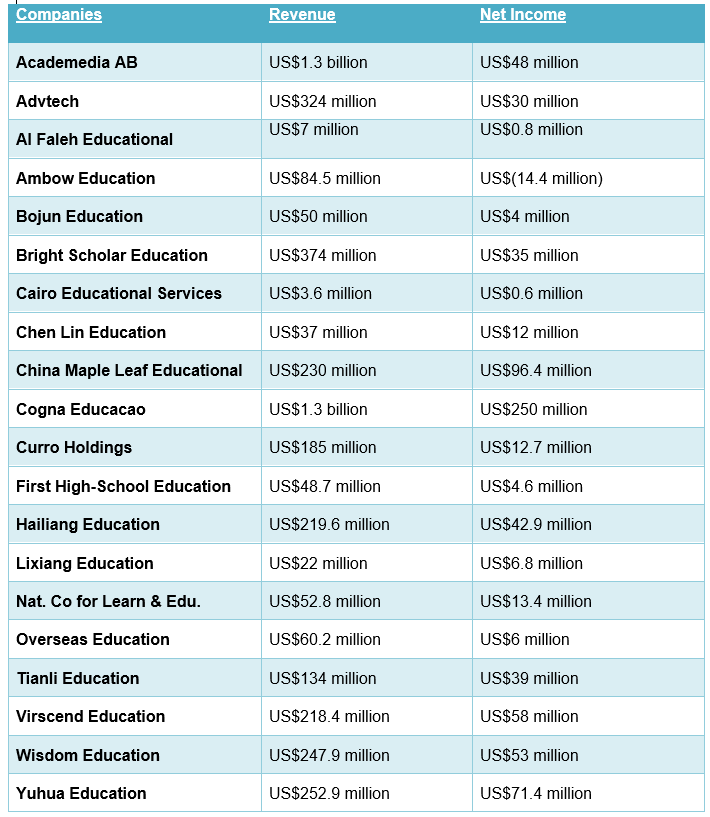
6.5 Funding Sources
1. Strategic Investors
- New Investor: A project leadership team with a strong business and financial acumen.
- Financier: Private equity firms specializing in international schools and investor groups.
- Educator: Education operator groups specializing in international schools.
- Developer: Project developers with expertise in international school ventures.
2. Private Equities and Investors
- Abax Investments
- Acumen Fund
- Alaska Investimentos
- Allan Gray
- American Century Investment Management
- Anchor Capital
- Apax Partners
- Apollo Global
- Arrowstreet Capital
- Atmos Capital Gestão de Recursos
- August Equity
- Aurelius Group
- Bain Capital Double Impact
- Baring PE Asia
- BDT Capital Partners
- Becker Capital
- Benchmark Capital
- Berkshire Partners
- Blackstone
- BNP Paribas Asset Management
- Bosera Asset Management
- Bregal Investments
- Bridgepoint Capital
- BTG Pactual
- Capital Group
- Carlyle Group
- Charterhouse Capital Partners
- China Asset Management
- China First Capital Group
- China Southern Asset Management
- China Universal Asset Management
- Citadel Advisors
- Citigroup Global Markets
- Clear Street Markets
- Copper Rock Capital Partners
- Cornerstone Capital
- CPE Capital
- Credit Suisse Asset Management
- CVC Capital Partners
- Davy Global Fund Management
- Denker Capital
- Deutsche Beteiligungs AG
- DFA Australia
- DIF Capital Partners
- Dimensional Fund Advisors
- Educate Global Capital
- EQT Partners
- eQ Varainhoito Oy
- Eurazeo Capital
- Fajr Capital
- First Trust Advisors
- Gaja Capital
- GIC Private
- GGV Capital
- Graphite Capital
- GSR Ventures
- Handelsbanken Fonder
- Henderson Global Investors
- HIG Capital
- HHLR Advisors
- HuaAn Fund Management
- Ibiuna Investimentos
- Indus Capital Partners
- Inflexion Private Equity Partners
- Inspara Partners
- Integra Group
- Intermediate Capital Group
- Invesco Capital Management
- Invision Private Equity
- Irish Life Investment Managers
- ISFC
- Jacobs Holding
- JP Morgan Asset Management
- Kagiso Asset Management
- Kaizen Private Equity
- KKR
- Levine Leichtman Capital Partners
- LLR Partners
- LOYS
- Lumina Impact Ventures
- Manulife Investment Management
- Marvin Holding
- Mekong Capital
- Mellon Investments
- Meritas Capital Partners
- Metric Capital Partners
- Millennium Management
- Montagu Private Equity
- Money Concepts Capital
- Morgan Stanley
- Navis Capital Partners
- Ninety One
- Nordea
- Norges Bank Investment Management
- Northstar Group
- OMERS Private Equity
- Owl Ventures
- Partners Group
- Patron Capital Partners
- PNC Institutional Asset Management
- Providence Equity Partners
- Quad Partners
- Rothschild & Co
- Ruffer Investment Management
- Sequoia China Investment
- Serenity Capital
- Shanghai Greenwoods Asset Management
- Sofina
- Southern Capital
- Sovereign Capital Partners
- SSgA Funds Management
- Sterling Capital Partners
- Sumitomo Mitsui DS Asset Management
- Summer Capital
- Swedbank Robur Fonder
- Temasek
- TIAA-CREF Investment Management
- Trustbridge Partners
- UBS Asset Management
- Vanguard Group
- Verod Capital
- Warburg Pincus
3. Consultants, education groups, fund managers to the international school industries:
- AAIE (Association for the Advancement of International Education)
- BCG (Boston Consulting Group)
- Bill & Melinda Gates Foundation
- Cambridge Assessment International Education
- Cairneagle
- Cognita
- Council of International Schools (CIS)
- Deloitte
- EduReach
- EY-Parthenon
- GEMS Education
- Global Services in Education
- Holoniq
- IB (International Baccalaureate)
- IFC (International Finance Corporation)
- International Schools Partnership
- International School Services
- ISC Research
- KPMG
- L.E.K. Consulting
- Mander Portman Woodward
- McKinsey & Company
- Minerva Education Group
- Mumtalakat Holding
- Nord Anglia Education
- PwC (PricewaterhouseCoopers)
- WISE Foundation
6.6 Positioning
World’s most expensive schools 2022

Life satisfaction among 15-year-old students
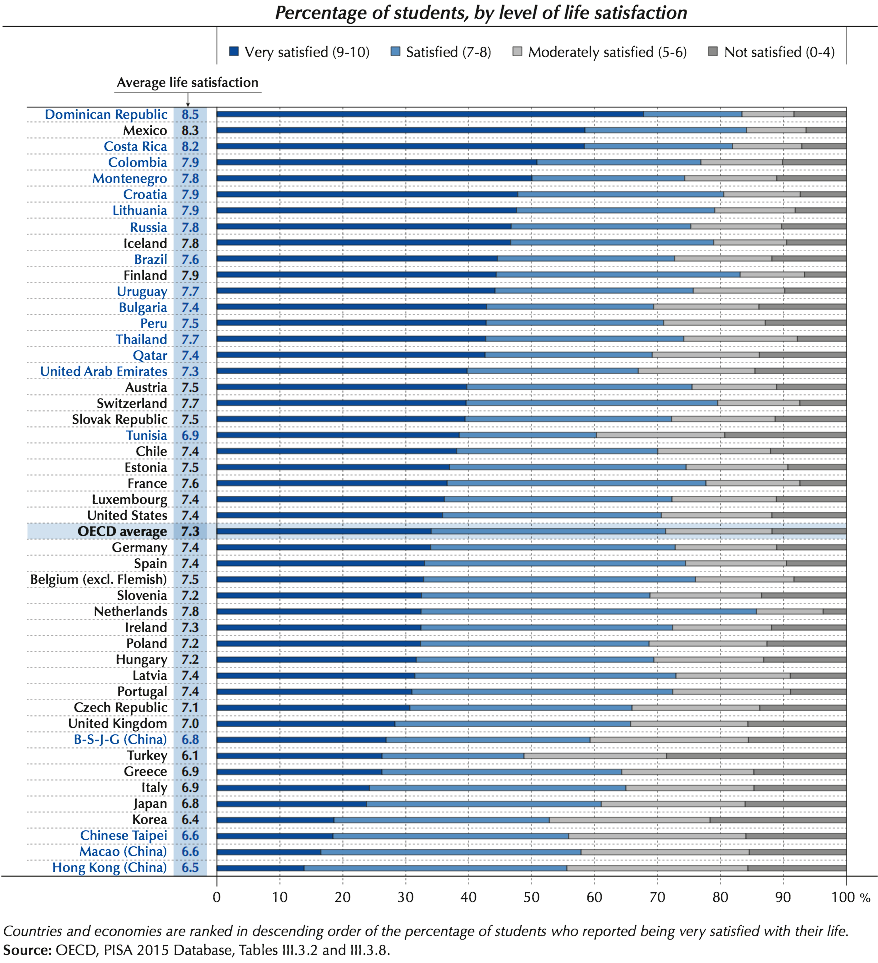
Top Independent Schools by A-Levels UK 2021 Global Top IB Schools 2021
Source: Best-Schools UK 2021 Source: IB-Schools 2021

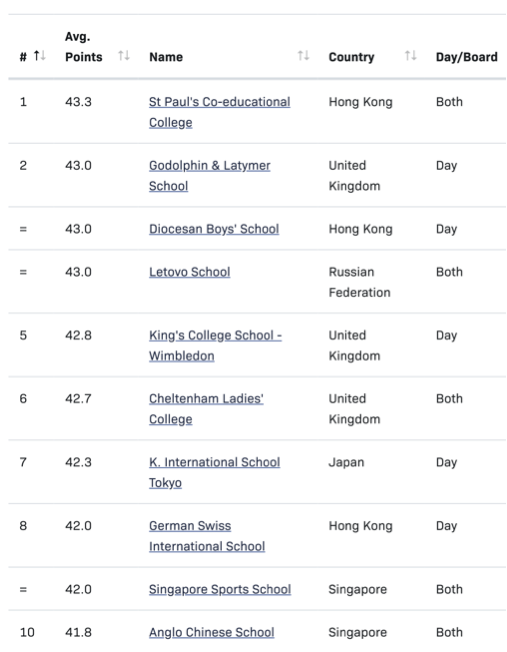
Disclaimer: The leagues tables are not associated with the International Baccalaureate Organisation.
Positioning is integral to shaping the strategic mission and purpose of the new international schools. It establishes the criteria for the niche target market, emphasizing elements such as uniqueness, academic excellence, and a harmonious study-life balance. Moreover, a portion of the profits can be dedicated to enriching the education of local community students, reinforcing the schools’ commitment to both global and local educational advancement.
7.0 Management Team
7.1 Key Management Team
- Mentors: Visionary pioneers and industry leaders with a global network, offering guidance and inspiration.
- Coaches: Mission-oriented industry experts providing practical solutions and keeping the team focused.
- Partners:
- Top international schools with operations in Southeast Asia or a disruptive vision.
- Funding specialists in international school education.
- Developers with land resources.
- Community support groups.
In the international education industry, several global leaders have made significant contributions, shaping its growth and success. Here is a list of some of these remarkable individuals, honoured for their vision and dedication:
- Jorge Amirola
- Ashwin Assomull
- Rupert Barclay
- His Royal Highness Prince Jefri Bolkiah
- Rick Johnson
- Sunny Varkey
- Liz Duffy
- Greg Parry
- Ryan Robson
These are just a few of the outstanding professionals and captains of the industry. The readers are encouraged to explore further and conduct their research to learn more about the management teams in this dynamic field.
7.2 Key Management Team Model
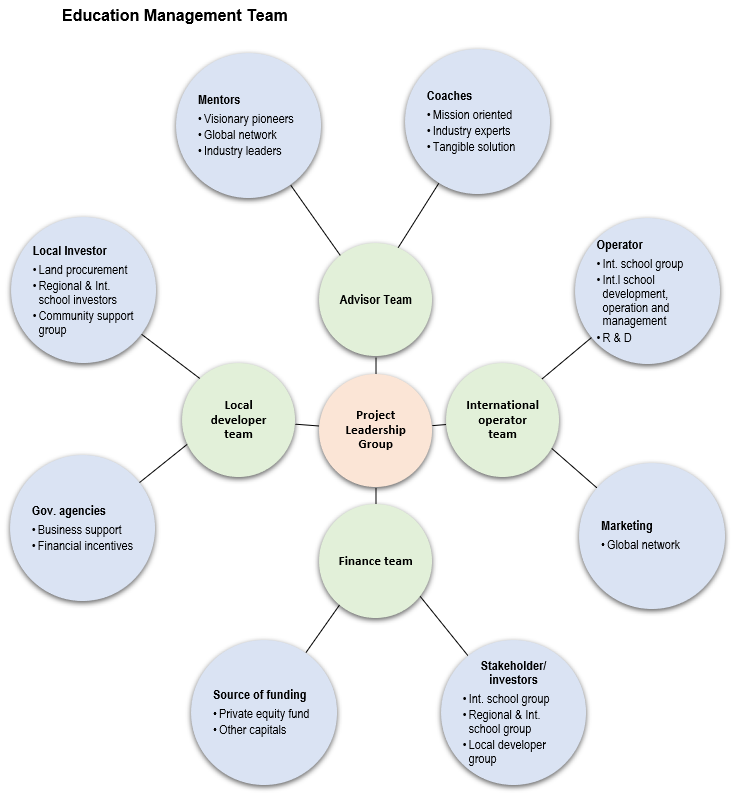
Source: Author
8.0 Unique Business Model
8.1 Success Factors
- Success: Proven excellence in student recruitment, academics, and curricula.
- Financial Growth: Consistent returns from student enrollment.
- Network: Strong alumni support.
- Global Team: International, experienced team.
- Teacher Development: Ongoing teacher training.
8.2 Entry Approaches
- Joint Ventures (JVs): Collaborative effort with stakeholders.
- Leadership Teams: Centralized school leadership.
- Operational Models: Franchise agreements or management deals.
- Funding: Private equity and investors.
- Local Partners: Collaborate with property developers.
8.3 Key Features
- Integration: Uniting top leadership, operators, funding, land, and strategy.
- Market Potential: Capitalize on new Indonesian capital and increased investments.
- Top Management: Led by a high-caliber team.
9.0 Key Success Factors & Risk Mitigation
9.1 Key Success Factors
- Support: Parent and international community support fosters effective communication across diverse cultures.
- Integration: Inclusive learning addresses challenges of international standard curricula, promoting competency through extracurricular activities and peer support.
- Teachers: Recruitment challenges require motivated and trained staff dedicated to student success, with a focus on core teams for continuity.
- Alignment: Managing relationships with board members and local communities is crucial for goodwill and addressing complex issues.
- Compliance: Navigating government regulations necessitates relational network programs and regular meetings to ease audits.
9.2 Risks
- Regulatory Changes: Changes in education regulations, economic downturns, political unrest, and terrorism.
- Disasters: Environmental disasters, like sudden flooding.
- Internal Issues: Internal factors, including harassment.
- Competition: Price erosion due to competition with other international schools.
9.3 Risk Mitigation
- Insurance: Provide kidnap, ransom, and salary continuation policies with staff training.
- Coverage: Political evacuation policies for emergency evacuation financial cover.
- Government Partnership: Engage local government for regulatory insight, forming an international school committee for feedback.
- Disaster Preparedness: Develop disaster risk management plans and training programs.
- Policy Enforcement: Implement disciplinary actions in school policies for non-compliance.
- Diverse Markets: Target a diverse student market to mitigate economic downturns in specific industries.
- Differentiation: Use product differentiation and branding to project leadership image.
10.0 Exit Strategy
10.1 Forms of Exit
- Forms: Exit options include IPO, buy-out, M&A, and transfer.
10.2 Key Attractions for New Investors
- Portfolio: International school projects offer stable, long-term returns.
- Uniqueness: Strong branding and unique features create a competitive edge.
- Barriers: High entry barriers due to substantial investment costs.
- Price: Prices outpace inflation, enhancing potential returns.
- Growth: Opportunities for growth in emerging markets.
- ESG: A commitment to responsible corporate ESG with purpose-driven investment.
